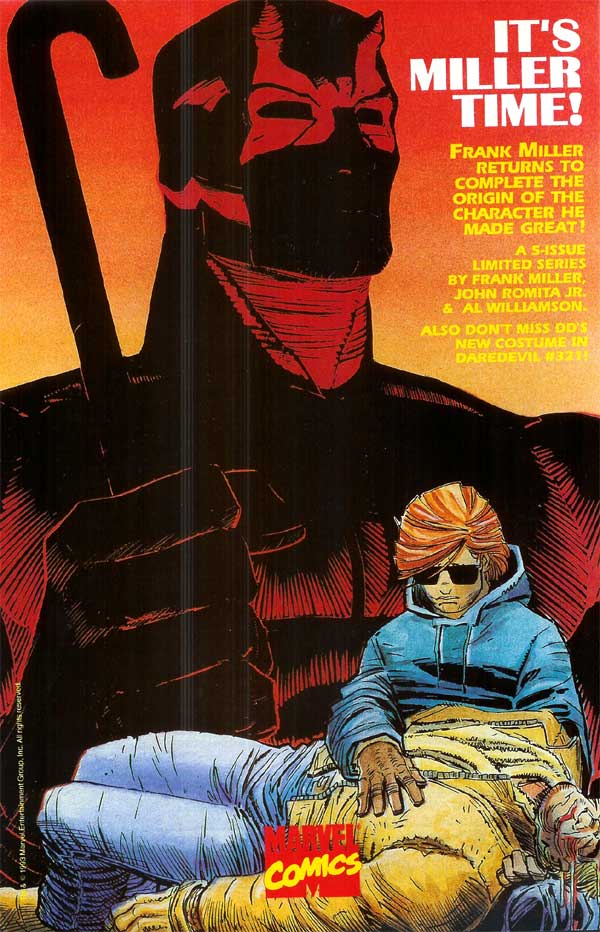












Chichester: In essence, I think that's right. Maybe not strictly from a "creative" level -- which I think
determines a story that feels like it needs to happen. To me, that's a story arc that comes out of straight inspiration. I'd put Fall of the
Kingpin in that category; or Jihad, the Hellraiser/Nightbreed "team-up"; or my run on Nick Fury with Jackson Guice,
where Von Strucker just
kicked the shit out of SHIELD. You're in a professional setting -- you're assigned to create for the title anyway -- but there's definitely a
muse running out ahead of you to frame out the page.
The need for Fall From Grace was, to my mind, more professional. The book was not doing well sales-wise. I think there were some good stories
in there, but they were probably good "one-offs." They lacked a larger vision. (Maybe another couple reasons Tom might have wanted me off the
book.) In retrospect, I have to wonder why we hadn't collaborated on a more comprehensive vision earlier.
I'd never blame Matt Murdock for keeping me in a rut. If there was a failing, it was in not taking full advantage of the character and the
opportunity he and his universe afforded. Maybe I was overextended, and was treating DD too much like one-of-many instead of first-in-class.
That certainly wasn't my perception, then or now, but it's a could-be.
So there was a professional need to DO SOMETHING. For sales. For grounding. To showcase the character -- and ourselves. Attempts to get some
marketing for the sake of marketing -- "Hey, throw us one of them scratch-and-sniff covers that are going to capsize the industry in a few
years!" -- were very much non-starters.
It's important to understand the internal attitude toward the character at the time. While there seems to be a pretty good clip of DD-related
titles and attention now, the company position toward Daredevil then was supremely dysfunctional. There wasn't a lot of interest in pulling him
into other titles, raising his profile. And if it wasn't Frank Miller (and his oft-times excellent work) on the character, they couldn't be
bothered promoting their own title. This was most evident and notorious in the Marvel PR headline for one of his projects (might have been Man
Without Fear, aka DD: Year One): "It's Miller Time!" Aside from mirroring hornhead with beer, and the questionable legality (and unquestionable
creative bankruptcy) of co-opting a brewery's slogan to sell a comic, Marvel in essence was saying, "If Frank Miller isn't writing this book,
it's not worth your attention."
So a combination of situation (some of our own making) and place-in-the-pecking-order drove that need as much as anything. I've referred to it
before as a need to make some noise.
Now, with that in mind, once we had identified that necessity, I'd argue that some very cool CREATIVE things came out of that. And if it hadn't
been Fall From Grace? It would have been another needy Daredevil story. Maybe better, maybe worse than what made it to the page.
It's legitimate to question the ultimate worth of FFG. I've read plenty of reviews that range from laudatory, to laugh-out-loud-hysterical.
Some made me grumble, "You just don't get it!" And some were savagely painful in their hard truths. But I would never let anyone question our
motivation. We loved working on that book and that character.
I remember sitting in a conference room when Scott sketched out that cover to #319. Just the power and surprise of those few bold and
unexpected strokes. It felt like we had something to prove. And we weren't going to go quietly into the night.
McDaniel: As I mentioned before, I felt I
was at a cross-roads in my career. Specifically, it was an artistic
cross-roads. At that time, the popular
style was the "west-coast" style, featuring a blizzard of fine lines and
cross-hatching and detail lines everywhere. Then Frank Miller
released Sin City with very graphic chiaroscuro styled art. I was
struggling to find my artistic voice, and you can see my internal battle
with
these two competing influences in DD #319, as some pages featured lots
of line detail and others were very graphic. I finally swayed toward
the graphic approach, which helped me compartmentalize the various
technical aspects of drawing (composition, form, lighting). Eventually
I
developed my own vision, but FFG definitely was a positive turning point
in my development. I felt the urge to grow, to develop a unique
style, and to make a name for myself. FFG was a great opportunity to
grow in new areas.
Mithra: Onto something a little different. I'll present some images throughout the interview and you can comment on whatever you'd like. Let's start with #319, the first issue.
Daredevil (and other related characters appearing) and the
distinctive likenesses are Trademarks of Marvel Characters, Inc. and are
used WITHOUT permission.
Copyright © 2009 Marvel Characters, Inc.
All
Rights Reserved. Visit Marvel.com.












COMICS:
Volume 1 | Volume 2 | Annuals
| Appearances | Costumes | Hardcovers | Key Issues | Logos | Origin | Price Guide | Recommended
|![]() Reviews | Secret Identity | Sales Data | Titles | Trades | Untold Tales
Reviews | Secret Identity | Sales Data | Titles | Trades | Untold Tales
![]()
CREATORS:
Cover Artists | Inkers | Pencillers | Writers
![]()
MEDIA:
Books | Cartoons | Computer Fun! | Movies | Music | Pictures | Sketches | Video Games | Wallpapers
![]()
FANS: Fan Art | Fan
Costumes | Fan Custom Figures | Fan Fiction | Fan Guitars | Fan Tattoos